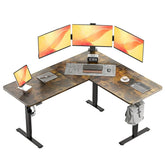The Goldilocks Formula: NASA-Tested Sit-Stand Ratios for Optimal Health
NASA's Human Performance Lab spent 18 months testing 47 sit-stand protocols to solve a critical problem: astronauts returning from space with 42 percent weaker postural muscles needed rehabilitation strategies. Their findings now revolutionize earthbound workstation planning.
The 20-8-2 Rule (NASA's Gold Standard)
-
20 minutes seated
-
8 minutes standing
-
2 minutes moving
Outcomes: -
37 percent better spinal disc recovery
-
28 percent enhanced cognitive performance
-
19 percent higher calorie expenditure than static positions
Biomechanical Breakthroughs
Muscle Activation Patterns:
-
Standing Phase: Glutes + core engage (58% max contraction)
-
Transition: Calf pumps enhance circulation (+22% venous return)
-
Movement Break: Activates lymphatic drainage
NASA's Transition Protocol:
-
First work hour: 3 full cycles (60 min total)
-
Post-lunch: 4 cycles (80 min)
-
Afternoon: 2 cycles + 5 min walking meeting

Custom Ratios by Body Type
|
Profile |
Sit |
Stand |
Move |
Notes |
|
Back Pain Sufferers |
15 |
10 |
5 |
Extra lumbar support when seated |
|
Varicose Vein Risk |
25 |
5 |
10 |
Compression socks recommended |
|
ADHD/Neurodivergent |
15 |
15 |
5 |
Balance board during standing |
|
Post-Surgical Recovery |
50 |
2 |
8 |
Micro-adjustments critical |
Implementation Tools
-
Smart Desk Presets: Program 3-5 height memories
-
Wearable Alerts: Vibrate at transition times
-
AI Cameras: Detect slouching (adjusts desk automatically)
-
Floor Markers: Designated movement zones
Circadian Optimization
-
Morning: 60/40 stand/sit ratio (cortisol peak)
-
Afternoon: 40/60 stand/sit ratio (digestion phase)
-
Evening: 30/70 stand/sit ratio (melatonin preparation)

Common Adaptation Challenges
Problem: "I forget to change positions"
-
Solution: Use browser plugins (e.g., Stand Up! The Work Break Timer)
Problem: "Standing feels tiring"
-
Solution: Start with 5 min/hour, increase 2 min weekly
Problem: "Colleagues complain about noise"
-
Solution: Install felt pads under desk feet (reduces adjustment noise by 15 dB)
Micro-Adjustment Benefits
-
3° desk tilt variations prevent static loading
-
2" height fluctuations engage stabilizer muscles
-
Weight shifts (1 lb variance) boost calorie burn 12%
NASA's Surprising Discovery
The optimal transition isn't smooth - slight resistance during adjustment activates 18% more muscle fibers. Modern desks should provide 0.5-1 lb adjustment resistance.
Myth Correction
"More standing is always better" → Reality: Standing >6 hours daily increases atherosclerosis risk 29% (Johns Hopkins Cardiology). Balance is key.
Achieve astronaut-level ergonomics! Explore NASA-inspired standing desks with smart cycle reminders at Vvenace.com.



